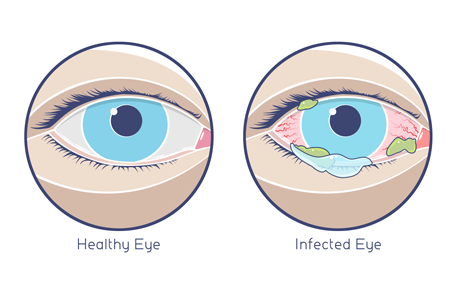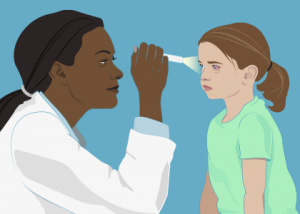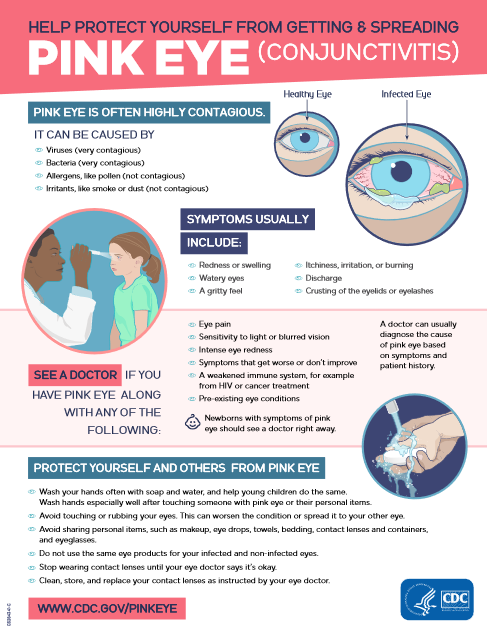Pink, itchy eyes? Pink eye – or conjunctivitis – is common and spreads easily. It sometimes needs medical treatment, depending on the cause. Know the symptoms, when to seek treatment, and how to help prevent it. Pink eye, also known as conjunctivitis, is one of the most common and treatable eye conditions in the world in both children and adults. It is an inflammation of the conjunctiva, the thin, clear tissue that lines the inside of the eyelid and the white part of the eyeball. This inflammation makes blood vessels more visible and gives the eye a pink or reddish color.

Four Main Causes of Pink Eye
Four Main Causes of Pink Eye
There are four main causes of pink eye:
- Viruses
- Bacteria
- Allergens (like pet dander or dust mites)
- Irritants (like smog or swimming pool chlorine) that infect or irritate the eye and eyelid lining
It can be difficult to determine the exact cause of pink eye because some signs and symptoms may be the same no matter the cause.
Symptoms of Pink Eye
Symptoms of Pink Eye
The symptoms of pink eye may vary depending on the cause but usually include:
- Redness or swelling of the white of the eye or inside the eyelids

- Increased amount of tears
- Eye discharge which may be clear, yellow, white or green
- Itchy, irritated, and/or burning eyes
- Gritty feeling in the eye
- Crusting of the eyelids or lashes
- Contact lenses that feel uncomfortable and/or do not stay in place on the eye
When to See a Healthcare Provider?
Most cases of pink eye are mild and get better on their own, even without treatment. However, there are times when it is important to see a healthcare provider for specific treatment and/or follow-up. You should see a healthcare provider if you have pink eye along with any of the following:
- Moderate to severe pain in your eye(s)
- Sensitivity to light or blurred vision
- Intense redness in the eye(s)
- A weakened immune system, for example from HIV or cancer treatment
- Symptoms that get worse or don’t improve, including bacterial pink eye that does not improve after 24 hours of antibiotic use
- Pre-existing eye conditions that may put you at risk for complications or severe infection
An infant or newborn with symptoms of pink eye should see a healthcare provider immediately. See conjunctivitis treatment for more information.
Stop Pink Eye from Spreading
Pink eye caused by a virus or bacteria is very contagious and spreads easily and quickly fro m person to person. Pink eye that is caused by allergens or irritants is not contagious, but it is possible to develop a secondary infection caused by a virus or bacteria that is contagious. You can reduce the risk of getting or spreading pink eye by following some simple self-care steps:
m person to person. Pink eye that is caused by allergens or irritants is not contagious, but it is possible to develop a secondary infection caused by a virus or bacteria that is contagious. You can reduce the risk of getting or spreading pink eye by following some simple self-care steps:
- Wash your hands
- Avoid touching or rubbing your eyes
- Avoid sharing makeup, contact lenses and containers, and eyeglasses
See conjunctivitis prevention for more information.
Pink Eye in Newborns
A newborn baby who has symptoms of pink eye should see a healthcare provider as soon as possible. Pink eye in newborns can be caused by an infection, irritation, or a blocked tear duct.
Neonatal pink eye caused by sexually transmitted infections, like gonorrhea or chlamydia, can be very serious. If you are pregnant and think you may have a sexually transmitted infection, visit your healthcare provider for testing and treatment. If you don’t know whether you have a sexually transmitted infection but have recently given birth and your newborn shows signs of pink eye, visit your child’s healthcare provider right away.
Most hospitals are required by state law to put drops or ointment in a newborn’s eyes to prevent pink eye. For more information, see conjunctivitis in newborns.
More Information
- Conjunctivitis
- Pink Eye: What to Do [00:03:59 minutes] – a pediatrician and parent reviews pink eye causes and treatment and suggestions on when to call or visit a doctor.
- Handwashing: Clean Hands Save Lives
- Conjunctivitis: Eye Disease Information (EyeSmart, American Academy of Ophthalmology)
- Facts about the Cornea and Corneal Disease (National Eye Institute, National Institutes of Health)

